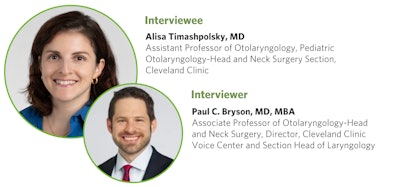Pearls from Your Peers: Tongue Tie Presentation and Management
Paul C. Bryson, MD, MBA, interviewed Alisa Timashpolsky, MD.

Can you define ankyloglossia? What types of ties exist in the pediatric population?
According to the AAO-HNSF Clinical Consensus Statement: Ankyloglossia in Children published in Otolaryngology–Head and Neck Surgery in 2020, the agreed-upon definition of tongue tie is a “condition of limited tongue mobility caused by a restrictive lingual frenulum.” The terms “anterior” and “posterior” tongue ties have also been used to describe different presentations of this phenomenon but are not well defined.
Upper lip ties are a normal occurrence in infants. The presence and relationship of an upper lip tie to breastfeeding has not been well described and cutting these ties in children with primary teeth will not prevent a gap between the incisors in adulthood. However, some women do describe their babies’ upper lip getting “curled” during feeding and cutting these ties can be considered after careful history taking and counseling.
Releasing buccal, or “cheek” tie, should not be performed according to experts in the field. This occurrence has been increasingly diagnosed by dentists but is not shown to lead to any functional deficits.
What are some of the common complaints of parents of children who present with ankyloglossia to the office?
Parents are often referred to our office by a lactation consultant or pediatrician if a newborn is having trouble breastfeeding in the first few days to weeks of life. Mothers report pain with latch, difficulty latching, prolonged breastfeeding, choking, or gagging during breastfeeding, or milk dribbling out the side of the infant’s mouth. Older children are occasionally referred by speech pathologists for poor enunciation and speech issues, though there is less evidence to support this.
What is some of the misinformation that exists regarding tongue ties that parents report to you in the office?
Parents of newborns are in a particularly vulnerable and fragile state of mind. Many mothers will read online forums and social media sites for information, desperate to see what can help their baby breastfeed. Some of the more unusual pieces of misinformation I have heard is that tongue tie can lead to chronic neck pain, headaches, scoliosis, and other musculoskeletal abnormalities. Another common one is that tongue ties can cause sleep apnea. All these statements are false. But unfortunately, there are many people in related and unrelated fields claiming to be experts sharing anecdotal testimonials that play on parental anxiety. This can be detrimental to clinical interactions and lead to misinformed expectations as well as unnecessary surgical procedures.
How are tongue ties managed? Do you perform these procedures in the office or operating room? What sort of instruments do you use?
Tongue ties in infants can be easily addressed in the office. Usually, I perform frenotomies using a retractor for the tongue and sharp curved scissors to incise the frenulum. Then I perform manual palpation with a finger until the tie feels fully released and the tongue has good mobility. Bleeding is minimal and usually stops with pressure. I will have the mother attempt breastfeeding immediately after the procedure in one of my exam rooms—and many report an immediate improvement. I have heard of dentists using lasers to perform frenotomies, but this is unnecessary and has not been proven to be superior to the traditional cold steel technique.
What are some pearls/takeaways that you would give to your colleagues starting off their pediatric ENT practice with regards to tongue tie presentation and management?
Referral patterns for tongue ties have drastically increased in recent years with more awareness and a higher emphasis on breastfeeding for mothers. I would advise all new practitioners to take a thorough history and physical to ensure true tethering of the tongue. While this procedure is easy to perform with little morbidity, proper counseling and tempering of expectations is important to avoid disappointment. Frenotomy can be one of the simplest yet most gratifying procedures that we do as pediatric otolaryngologists if performed in appropriately selected patients.




















